Pion-shaped aster: varieties and cultivation

Asters have long been renowned for their beauty, vibrant bloom and pleasant aroma. They become a decoration for flower beds and bouquets for many flower growers. One of the most famous and favorite types of asters are the peony. The color palette of this plant is amazing, and its simplicity in care pushes even novice gardeners to start growing. Let's figure out how to grow a peony aster.


Peculiarities
The name of the variety "aster" has Greek roots and means "star" in translation. Indeed, wonderful flowers are similar to celestial bodies, but the palette of colors of the "earthly stars" is much wider. Even legend says that asters appeared from stardust that fell from the very heavens. Peony aster is a genus of perennial bush plants with a powerful root system and large flowers. The bush itself belongs to medium-sized species and grows up to 70 cm in height. Its stems are not too branched and erect, lateral shoots grow extremely rarely, which allows them to keep their columnar shape well.
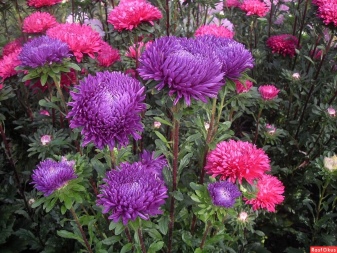

The flowers of the peony aster are very similar in shape to peonies, for which the plant got its name. The inflorescence is presented in the form of a double basket with short inner petals and longer outer ones. Similar to tongues, they are directed towards the bright yellow center, which gives the flower a shape similar to a colored ball. The diameter of the flowers can be from 8 to 15 cm, and the color is white, burgundy, pink-purple or yellow. Blooming aster pleases its owners from mid-summer to the end of September. They often bloom magnificently and brightly, while exuding a pleasant and sharp floral scent. The plant gets along well enough with other flowers in the neighborhood, and therefore can be an excellent addition to a flower bed.


Varieties
Thanks to the efforts of breeders, there are many different varieties of asters in the world. If you want to start breeding asters in your garden, then you should take the most popular varieties (Tower, Lady or Duchess), since they are not too demanding in terms of care. Consider the most common types of peony asters.
- "American Browning (branching)" mix - a variety characterized by a significant bush height (up to 70 cm) and the color of the petals in red-blue shades.


- "Red Tower" - the variety most suitable for bouquets. It has a bright carmine color and flowers about 10 cm in diameter.

- "Silver Tower" - a variety that is characterized by a unique color gradient from lavender to white in the middle, large and double flowers delight with flowering from early August until the beginning of frost.

- "Yellow Tower" - bright yellow saturated flowers up to 11 cm in diameter.

- "Pink Tower" - deep pink asters, stem length about 60 cm, perfect for the formation of bouquets.


- "The gray-haired lady" - a unique variety, the petals are purple-blue and have a silver (gray) rim at the edges, they can reach 13 cm in diameter.


- Versailles - a bush that can produce up to 7-9 snow-white flowers.
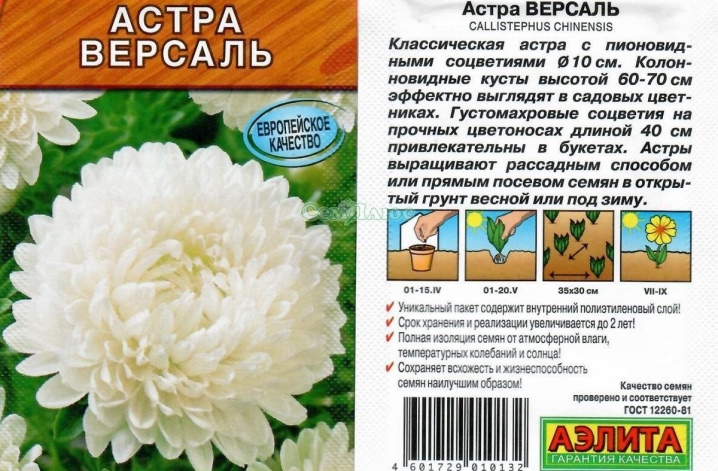
- "King size" - most often sold as a mixture of colors, and the variety got its name for the size of flowers, which can reach 15 cm, and the stem is 80 cm.


- "Apricot Tower" - pale orange flowers on a stem about 60 cm.


- "Quartz Tower" - flowers are silvery at the base of the petal and pink at the tips, 8-10 cm in diameter.
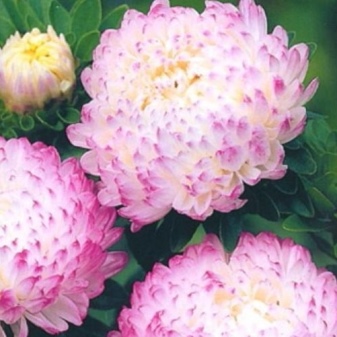
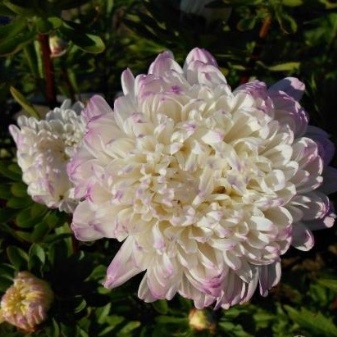
- "Duchess" - pale pink flowers, large (up to 12 cm), growing on impressive bushes.


- "The Dragon" - a variety with double, bright pink flowers reaching 12 cm in diameter.


The choice of a variety is carried out depending on the size of the expected flower and the desired combination in landscape design.
How to plant?
After you have chosen the desired variety, it is worth learning how to plant aster seeds. Before planting, it is worth prophylactically pouring the seeds with a weak solution of potassium permanganate for a period of about half an hour, if the substrate for planting was collected independently. Purchased seeds have already been processed.

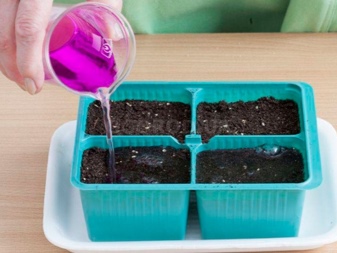
In advance, you should purchase nutrient soil for asters in a special store, but you can simply fertilize the land on the site with river sand and wood ash, rotted compost or peat. Asters prefer to grow in loose, airy soil. For planting in containers, it is also recommended to think about drainage from rubble, brick or expanded clay, as well as holes in the bottom.
Immediately before planting (in early May - mid-July), be sure to moisten the ground. Then, furrows are made no deeper than 1 cm, into which the seeds are sown. After that, they are leveled with earth and again sprayed with a small amount of water from the sprayer. The containers are removed on a windowsill with access to sunlight at a temperature of 18-19 C.

Seeds germinate in no more than 11-12 days. When a pair of real leaves appear on the sprout, the seedlings should be picked up, seating future asters in separate pots or glasses. The seedlings will be ready for planting in the ground 25-30 days after germination.
A place for the further growth of asters in the open field should be sunny and not very windy. They dig a shallow hole according to the size of the root system, moisten, drainage is poured to the bottom and fertilizers are added. Seedlings are planted, a hole is buried and watered. All this is done in May.
In the case of sowing seeds directly into open ground, it is worthwhile to wait a little until the end of April. Asters grown in this way will be more hardened and resistant to diseases, they will bloom more profusely, but a little later.

After planting, you should cover the area with asters with a film, and after germination, it is worth thinning them (as if to dive), so that there is 15 cm between the plants.

How to take care of it properly?
After planting, further care for the peony aster consists in loosening the earth around it, watering, removing weeds, fertilizing at the very beginning of the flowering period and before the formation of buds. For the purpose of fertilization, the drug Agricola can be used. Experienced gardeners recommend using the 3/1 scheme: the plant is watered for 3 days, on the fourth - the soil is loosened around (on this day the plant is not watered).
Cultivation becomes safer if the soil is periodically disinfected with a solution of copper sulfate.


Reproduction methods
The most common breeding method for peony asters is by seeds. It is better to purchase them in the store, as self-assembled ones can grow in a completely different color. If you want to grow seeds harvested personally, then it is worth remembering that they will have the greatest germination for the next year, and therefore you should not store them and wait for years.
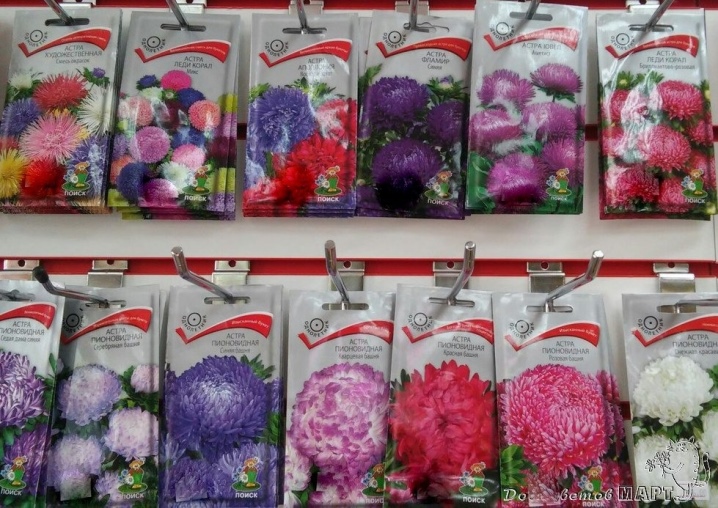
Diseases and pests
Like any other plant, the peony aster is extremely susceptible to disease and attack by pests.
Pests
A lot of trouble can appear for the owners of asters because of slugs, thrips, nematodes, caterpillars, pennits. You can cope with annoying parasites using the good old methods - spraying the bushes with infusions of garlic, onions, weeds, calendula or soap. To prevent the attack of pests, it is worth worrying about this in advance and planting plants such as calendula or marigolds nearby. Another good remedy for parasites is the usual solution of potassium permanganate. Once the parasites have been killed, the flowers can continue to grow and bloom equally profusely.
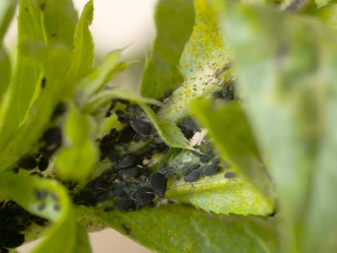

Diseases
Often and densely, asters are affected by diseases. This happens if the plant was poorly cared for, little fertilizer was applied or the soil was not taken into account, it was planted too densely, as well as due to the influence of bad weather conditions or stagnant water.
- Most often, the flower is affected by powdery mildew, while the bush becomes covered with a white bloom, as if someone had sprinkled it with flour. Prevention of this condition is carried out by improving the quality of plant care, etching is carried out with the same solution of potassium permanganate. If it was not possible to avoid the disease, then it is worth buying drugs like Topaz, Sulfaride, Polyhoz or Fundazola in a specialized store. Do not spray them in the heat, it is better to leave it until evening. Before use, be sure to read the instructions.
- The second most common disease is fusarium, which provokes the complete wilting of the leaves, and only complete removal of the affected parts or even the entire plant can help.
- Often, asters can be affected by a fungal disease, which appears by the appearance of dark, rounded spots on the leaves. You can save the plant by immediately removing and disposing of the affected leaves and treating the rest of the bush with Fundazol or Polynom.
- Unfortunately, there is no salvation from jaundice, accompanied by the appearance of yellowish spots. The affected bushes are disposed of.
- Gray rot can occur due to stagnant water or excess nitrogen, while the plant is covered with a gray-white bloom. Damaged areas of the flower should be removed to prevent infection of the rest of the bushes.


Peony aster does not require too much effort and energy to grow and care, but in return it will give all its bright colors, decorate flower beds and bouquets, pleasantly surprising the guests.
Next, watch a video with tips on how to properly sow aster seeds for seedlings.







































































































The comment was sent successfully.